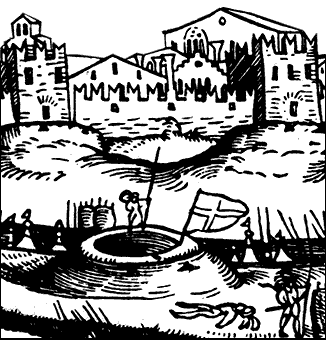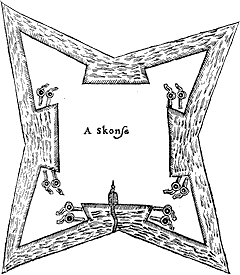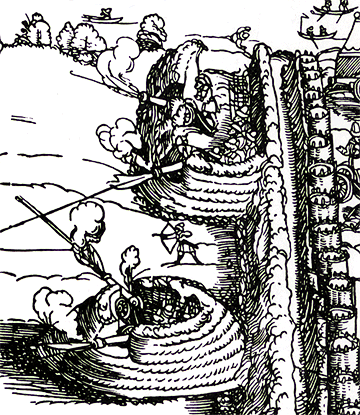 |
Ensconced in Sconces |
Early in the development of the artillery fort, a set of outworks called sconces provided flanking fire for the fort. These were particularly effective in supplementing fire and covering blind spots for old round towers. Sconces were simply round holes in the ground, about three or four meters in diameter, with the excavated dirt ringed around the holes. Slots for cannon barrels sometimes were added. Nothing more!
Sconces made a perimeter defense for the fort, and were so spaced
and placed that they supported each other and the fort with
overlapping lines of fire. Their crossfire caught any
intruder.
 |
|
Very likely German in origin, defenders dug these simple sconces until around 1535. German infantry holding Pavia against the French in 1525 used them.
 As the pimple-like sconces were disappearing, engineers and
architects expanded upon the idea of the sconce with greater
sophistication. By the 17th century where used (and they were not
used everywhere) sconces were little versions of artillery forts
complete with bastions and ditches (or moats like the example at the
left). Some were
square, with four bastions, or even three-sided, and distinctly
smaller than the artillery fort or town walls they supported.
Sometimes this latter concept of the sconce was expanded upon to
make the citadel.
As the pimple-like sconces were disappearing, engineers and
architects expanded upon the idea of the sconce with greater
sophistication. By the 17th century where used (and they were not
used everywhere) sconces were little versions of artillery forts
complete with bastions and ditches (or moats like the example at the
left). Some were
square, with four bastions, or even three-sided, and distinctly
smaller than the artillery fort or town walls they supported.
Sometimes this latter concept of the sconce was expanded upon to
make the citadel.
One of the simplest outworks was not conceived until 1556: the covered way. It proved very effective for keeping the enemy from the ditch, and especially to provide outside defenders a protected avenue for moving from one side of the base fort to another.
| Back |
Covered Way & Glacis |
|
|
|
